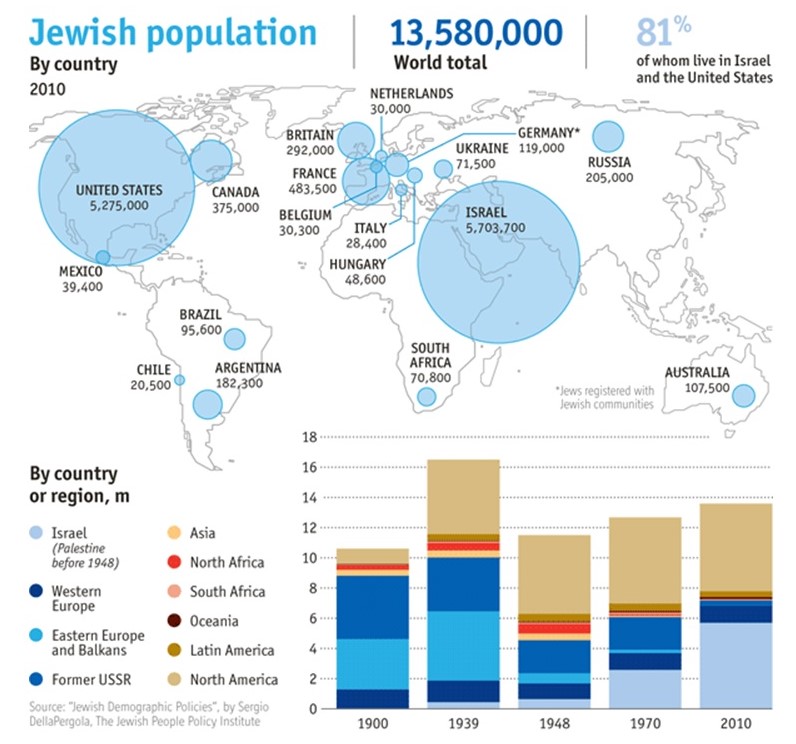Introduction
Judaism is the religion, philosophy and culture of Jews. There is a common misconception, however, about whether being a Jew means following the religious ways of Judaism. Contrary to popular beliefs, a lot of Jews do not even believe in their religion at all. Those people who prefer themselves to be called secular do not believe in the existence of God and often do not belong to any synagogues (“What Is Judaism?”, par. 3). They might celebrate some of the Jewish holidays and practice some rituals, but they do not treat it as religious doings. Such denomination is informally called secular Judaism. Numerous other denominations divided the Jewish community, such as Orthodox, Ultra-Orthodox, Reform, Conservative, Reconstructionist and Humanistic Judaism.
Main body
Jews are well-known for being persecuted in many countries, hence why their population and geographical distribution have often fluctuated through centuries. Today, they mostly live in Israel, Europe and the United States. Considerable concentrations of Jews can be found in Asia, Africa, Latin America and Europe. Russia also used to have a large population of Jews, notably in the western part but lost it due to the immigration of Jews to Israel and the USA. Europe also had a much larger population of Jews than currently (especially in eastern Europe), but World War II and the Holocaust have reduced Jews’ population approximately by 6 million people (“Mapping Judaism”, par. 1).
Among all the Middle East religions, Judaism is considered as the oldest one. Its amount of followers, however, pales in comparison to Islam or Christianity (“People of the Book: Comparing Judaism, Christianity and Islam”, par. 5). All three religions are considered Abrahamic, meaning that the Prophet Abraham plays a foundation role in all of them. Islam and Judaism share a lot of similarities in their teachings, as they are both monotheistic religions that place God as the ultimate being, but they also have certain differences. Namely, Jews treat their material success as the core religious value above all other concerns. They also consider themselves as God’s chosen, and that the non-Jews are there to be used by them. Islam does not agree with Jews’ perception of themselves as the supreme race. According to Islamic beliefs, no person is better than another in the sight of Allah. Promotion and prescribing of universal morality is the essential difference between Islam and Judaism (“Differences Between Islam and Judaism”, par. 9). The one thing that Jews also do not agree upon with Islam, and even more so with Christianity, is the position of Jesus Christ. Judaism does not consider Jesus Christ as the Messiah or divine person; thus, his relevance is almost non-existent.
Israel political parties
Two main political parties in Israel that are considered as Ultra-Orthodox are Shas (Sephardic Guards) and United Torah Judaism (“Israel’s Political Parties”, par. 25). Both parties defend the interests of Haredi Judaism, which was created as a response to the modern secular culture in Israel. Shas currently has 11 seats, while the United Torah Judaism party has seven seats. Ultra-Orthodox parties are very interested in maintaining Israel’s status quo along with advocating a state run according to Jewish religious law. For providing the needed votes to certain prime ministers, Ultra-Orthodox parties have been granted great power and influence. With such power in their hands, they intended to roll back the religious reform and legislation on national services and education. The previous government introduced laws on mandatory military service of Haredi Jews and the addition of Mathematics and English to their school education system (Sales par. 3). The agreement between Likud and UTJ parties reverted those changes. Haredi Israelis have received automatic exemptions from compulsory military service, an obligation to teach secular subjects in schools, as well as funds necessary for their separate school system. Secular Israelis were not happy with such a decision, as they consider Ultra-Orthodox parties as a burden to the national economy.

References
Differences Between Islam and Judaism 2012. Web.
Israel’s Political Parties 2015. Web.
Mapping Judaism 2012. Web.
People of the Book: Comparing Judaism, Christianity and Islam. n.d. Web. 2015.
Sales, Ben. Ultra-Orthodox Parties Aim to Roll Back Religious Reform. 2015. Web.
What Is Judaism? n.d. Web. 2015.